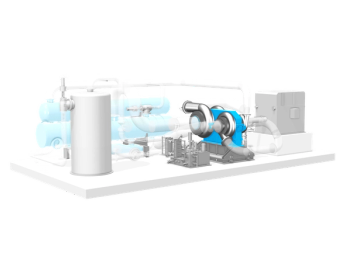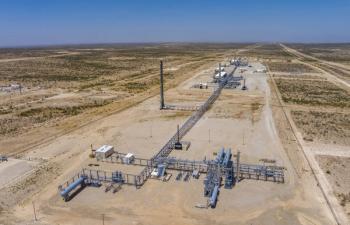
STRESS CORROSION CRACKING
UNDERSTANDING THE CAUSES CAN HELP MINIMIZE
DOWNTIME AND IMPROVE RELIABILITY
By Eesan Vamadevan
Steam turbines are used across the world as a source of power for many different industries. Even with the best maintenance procedures and preventative maintenance techniques, problems can arise.
Older steam turbines, for example, are prone to stress corrosion cracking of the turbine blades. Understanding the causes can help minimize downtime and improve reliability.
Take the case of an integral steam turbine rotor that developed cracks in the root sections of the row six disk. The turbine had an operating speed of 9,900 rpm and the steam inlet temperature was 400°C (750°F). The equipment had been well maintained.
The hook section of the disk, however, was under high stress. The design of this rotor used two root lengths to offset the stress loading and minimize the risk of cracking in the disk. Despite this, seven roots with cracks were identified using a magnetic particle inspection (MPI) process.
Engineers conducted inspections to determine the cause of the cracks. Four cracks were opened mechanically to examine the fracture surfaces using a scanning electron microscope (SEM). This highlighted evidence of intergranular cracking. Other fracture mechanisms, such as fatigue, appeared to play no role in failure.
Optical metallography was also used to examine a section of the cracked area and found branched cracking immediately below the fracture surface. In conjunction with the findings from the SEM observations, the cause of the cracks was confirmed as stress corrosion cracking.
Material composition
Chemical analysis and testing of the mechanical properties of the components involved in any failure is important. The ASTM A470 Grade C alloy used in the composition of the rotor disk was found to have higher tensile strength that the maximum value specified. This can often lead to increased susceptibility to corrosion.
Further investigation used energy dispersive spectroscopy (EDS) to determine the chemical composition of the material at the fracture surface. Aside from the expected elements in the base metal alloy, EDS identified sodium, magnesium, tin and chlorine. The most likely source of these elements was steam used to power the turbine.
To address all the possible causes for rotor disk cracks, an investigation into stresses was carried out using finite element analysis (FEA). A 3D computer-generated model looked at maximum stress values while the rotor operated at its maximum continuous operating speed (MCOS).
The stresses in the disk at the short blade root exceeded 100 ksi along the root axial width. However, this was less than the measured yield strength of the material of 125 ksi. This provided further evidence that stress alone was not sufficient to cause the material to yield. Stress corrosion cracking was the primary cause of the failure.
When cracking occurs
Stress corrosion cracking occurs due to the presence of three conditions:
• The alloy is susceptible to stress corrosion cracking
• The stress intensity factor is above the threshold value
• A corrosive environment is present.
In this example, higher tensile strength levels made the alloy more susceptible to corrosion. The location of the high-stress region within the disk corresponded with the crack initiation locations found during the MPI. The presence of chlorine at the fracture site indicated a corrosive atmosphere, which further confirmed stress corrosion cracking as the cause of failure.
To avoid stress corrosion cracking, it is only necessary to remove one of the above conditions. Modern steam turbine components use the latest alloys as well as different blade root designs.
In this case, redesigning the blade root to reduce the peak stress levels was not feasible as the ball root design was compact and would not allow for much improvement in the stress profile. Therefore, the best approach was to improve steam quality by eliminating corrosive agents.
Failure of the row six disk’s root section was also investigated. Apart from some minor variations in material quality, the major mechanical property that did not meet the required specification was the measured impact value. It was found to be considerably below specifications.
Further SEM investigation showed that the entire fracture surface exhibited an intergranular failure mode. This was confirmed after assessment of a polished section inspected using optical microscopy. It also indicated branched cracking.
In addition, EDS analysis found heavy oxide on the fracture surface. These findings confirmed stress corrosion cracking as the cause.
Chemical etching of a polished sample of the fracture surface made it clear that the microstructure did not show fully tempered martensite. Combined with the low-impact values, this indicated that the forging had not been properly heat treated. This may have accelerated crack propagation in the disk.
Author: Eesan Vamadevan is Senior Metallurgist at Sulzer.
Newsletter
Power your knowledge with the latest in turbine technology, engineering advances, and energy solutions—subscribe to Turbomachinery International today.




